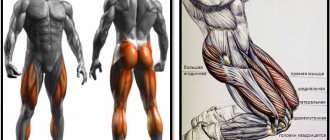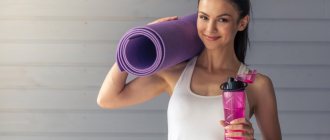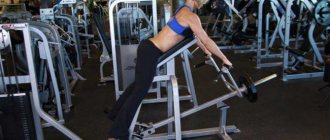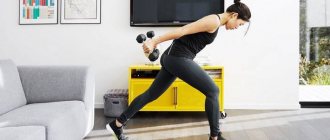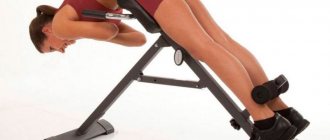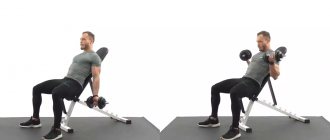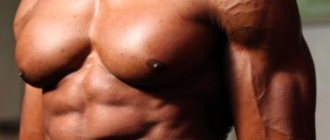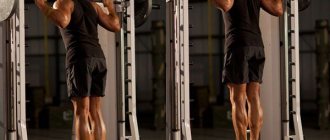To relieve nagging, aching, pressing pain in the lower back, doctors recommend performing physical therapy exercises daily. Regular training not only eliminates discomfort, but also strengthens the back muscles and improves posture. Classes will be therapeutically more effective if the set of exercises is compiled by a physical therapy doctor. He will definitely take into account the diagnostic results, the cause of lumbar pain, and the general health of the patient.
In what cases are exercises indicated for relieving back pain?
It is advisable to eliminate lower back pain at home after finding out the cause of its occurrence. This symptom is characteristic of many diseases of internal organs - cystitis, cholecystitis, pyelonephritis, prostatitis, uterine fibroids. This requires complex treatment, and physical education is indicated only during rehabilitation.
You can get rid of pain in the lower back with the help of exercises if you have osteochondrosis, spondyloarthrosis, protrusion, or intervertebral hernia. Certain sets of exercises have been developed for exercises during remission and during exacerbations of these pathologies. In the latter case, they are usually performed in the presence of a doctor who controls the load.
Why does my lower back hurt?
Low back pain is very common. What is the source of low back pain?
problem and the second most popular reason (after colds) for visiting a doctor. The causes of pain can be very different: injuries and muscle spasms, damage to ligaments and tendons, degeneration of intervertebral discs, inflammation, compression of nerves and even kidney stones or oncology.
If the pain has not yet forced you to see a doctor, most likely it is not severe and only appears from time to time. For example, after a long day of work in an uncomfortable position or in the morning.
You can easily cope with such sensations with the help of simple exercises.
Efficiency of classes
Daily physical exercise is the most effective method of treating degenerative diseases of the lumbar spine. By taking analgesics and muscle relaxants, it is only possible to get rid of symptoms temporarily. And doing the exercises allows you to take a comprehensive approach to solving back problems:
- strengthen muscles, stabilize discs and vertebrae in a physiological position;
- improve blood supply to bone, cartilage, soft tissues with nutrients;
- reduce the severity of pain or completely get rid of it.
Building up a muscle corset helps prevent disc displacement, pinching of blood vessels and spinal roots by them and bone growths. Therefore, gradually, along with the pain, other symptoms of osteochondrosis or spondyloarthrosis - sensory disturbances, stiffness of movement, paresthesia - disappear.
Guidelines for the third period (remission)
In this period, the task of increasing the mobility of the spinal column is added to the tasks and methodological features of the second period. However, exercises aimed at solving this problem should be carried out carefully and in lighter starting positions. It is necessary to achieve automaticity in maintaining a specific posture in a standing position and while walking when the lumbar spine is kyphotic.
The number of repetitions of special exercises of the second period increases to 50-100 times (can be broken down throughout the day). Among other means of exercise therapy, it should be considered advisable to use those that will not have a negative effect on degenerated discs: swimming, health path, skiing, treadmill, bicycle ergometer, exercises with a rubber band. Use such means as volleyball, tennis (big and small), road cycling, cross-country running, fast dancing, rhythmic gymnastics should be extremely careful, because sudden, often uncoordinated movements and turns can provoke an exacerbation of osteochondrosis. Exercises with dumbbells are preferably performed in the IP position. lying down (on your back, stomach) to eliminate vertical loads on the spine.
It should be considered inappropriate to use pure hanging to supposedly stretch the lumbar spine. An obstacle to this is the powerful tension of the stretched muscles of the torso. Depth jumps from elevated positions, exercises on a rowing machine, and throwing are also undesirable. In any case, when practicing exercise therapy, you should remember that constant microtrauma and overload of the spine, uncoordinated movements, shocks along the spinal axis prepare the appropriate background for rupture of the degenerated disc and exacerbation of the pain syndrome. These recommendations must be taken into account when choosing means and forms of physical exercise at the sanatorium and outpatient stages of rehabilitation.
In the third period, the use of therapeutic exercises in the pool is recommended. It should be noted that therapeutic exercises in the pool do not replace, but complement the main “dry” exercises with therapeutic exercises.
General execution rules
The room should be well ventilated before training. But it should not be cool in it, otherwise there is a risk of catching a cold in the lower back. For exercise, you need to choose clothes made of breathable materials that absorb moisture well. It is also necessary to follow the recommendations of exercise therapy doctors:
- make movements smoothly, a little slowly;
- increase the pace gradually, do not try to complete all the exercises in the first lessons;
- If pain occurs, stop training and resume it only after a long rest.
It is important to listen to the sensations that arise. If after performing a certain exercise the pain intensity decreases noticeably, then it should be repeated more often.
How often should you pump your back?
We bring to your attention a small set of special gymnastic exercises that you can perform at home. It does not require special equipment and will not take much time. Do it only 2, maximum 3, times a week at a time convenient for you. We recommend including it in the second half of your morning hygiene exercises. This load will be quite enough to strengthen the back muscles.
Don’t be surprised, but the complex also includes several exercises for the abdominal muscles, since it is simply impossible to become the owner of strong back muscles without having strong abs. There is also a movement to work the oblique muscles of the torso.
When performing exercises, adhere to the following rules:
- follow the sequence of exercises;
- dosage of exercises - up to “oh, I can’t do it anymore” + 2 more times for dynamic movement or + 5-7 seconds to hold a static position;
- between exercises, try not to pause longer than 15-30 seconds;
- Repeat the entire complex three times, 2 breaks between them should last until the discomfort in the muscles disappears.
Relieving acute lumbar pain
An attack of lumbago manifests itself as acute pain in the lower back. It is so piercing and burning that a person cannot even get to bed without assistance. Therefore, at this time there can be no talk of any activities. They begin several hours and even days after the severity of pain has subsided.
Pose "Cat-cow"
Get on all fours, simultaneously lower your head and round your back. Return to the starting position, bend your lower back, lifting your chin. The number of approaches is 5-7. Some soreness after an attack of lumbago is quite natural. But when it becomes stronger, a long rest is required.
Child's pose
Get down on your knees wide apart so that your feet touch each other. Stretch your arms in front of you and move your body forward with a sliding movement, touching your forehead to the gymnastics mat. Stay in this position for 10-15 seconds, return to the starting position. Repeat the exercise 4-5 times.
Exercises with a chair
Kneel down in front of a stool or chair, trying to keep your back straight. Place your hands on the seat for support. Smoothly bend and bend your lower back 8-10 times. In the same body position, bend first in one direction, then in the other direction. When performed correctly, the exercise places the main load on the lateral muscles of the back, not the lower back.
Lying stretch with torso turning left and right
Lie down, straighten your legs, spread your arms to the sides. As you inhale, bend your knees and turn them to the right, holding this position for 5 seconds. Exhale, return to the starting position. Repeat the movements 5 times, then perform the exercise in the other direction.
Torso rotations from a sitting position
Sit on the mat, bend your right knee and bring it behind your straightened left leg. To maintain balance, lean on the floor with your right hand. Turn to the left, using your free palm to lightly press on your knee. Perform the exercise 3-5 times in each direction.
Stretch "Shell"
Get on all fours, take a deep breath and lower your buttocks onto your heels, without lifting your palms from the floor. Stretch well, tensing the muscles of the lower back, take the starting position of the body. The number of approaches is 5-10.
Methodological recommendations for motor mode in the acute period
In the acute period, in the presence of acute pain, strict bed rest should be observed. Exercise therapy is used mainly for hygienic purposes and is of a general strengthening nature. When moving the lower extremities, do not allow the lumbar lordosis to increase, which can increase pain. In this regard, when performing physical exercises, you should place a soft cushion under your shins.
At the second stage of the acute period, with a slight decrease in pain intensity, isometric exercises should be carefully included to train the abdominal muscles and gluteus maximus muscles.
Exercises that cause pain should be limited in amplitude, degree of muscle tension, or eliminated altogether. Do not exercise through pain!
The number of repetitions of each exercise is 8-10 times. The pace of the exercises is slow.
Relief of moderate lower back pain
Moderate lower back pain often precedes exacerbation of spondyloarthrosis or osteochondrosis. To eliminate them and prevent relapses, exercises are used to stretch the muscles of the entire back.
Wall Squats
Rest your back against the wall, spread your feet shoulder-width apart, clasp your fingers and place them in front of you at chest level. Slowly perform a shallow squat, hold in this position for 10 seconds, and return to the starting position. Repeat all movements 5-7 times.
Low back flexor stretch
Lie down with your knees bent and your feet on the floor. Pull one leg towards your chest, clasping the back of your thigh with your hands. Stay in this position for 10-20 seconds, take the starting position. Repeat 5 times, perform the exercise with the other knee, and then lift both legs at once.
Hyperextension
Lie on your stomach, bend your arms, placing your palms near your shoulders. Taking a deep breath, raise your upper body for 10 seconds. As you exhale, lower yourself to the floor. The number of approaches is up to 10. When performing the exercise correctly, the muscles of the lower back, not the shoulder girdle, should be tense.
Exercise to correct pelvic tilt
Lying on your back with your legs raised straight, press your lower back firmly into the mat. Slowly lower your legs down. Bend your knees only when your lower back begins to lift off the floor. Perform the exercise 10-15 times.
When should you see a doctor?
If you follow the above tips and your condition does not improve, you should consult a doctor . Warning signals may include the following criteria [15]:
- Back pain lasting longer than 6 weeks
- The pain gets worse over time
- You are under 20 years old or over 55 years old
- Even the slightest touch hurts you
- Increase in temperature
- Rapid weight loss for no apparent reason
- Tingling in the legs
- Feeling weak
- You begin to urinate slowly or suffer from urinary incontinence
If you notice these symptoms , this does not mean that you have a bad back. However, it would be good to go to the doctor and get examined.
Other exercises
It is easier to prevent the appearance of lower back pain than to eliminate it for a long time, including with medication. For this purpose, a set of exercises has been developed, the implementation of which becomes an excellent prevention of exacerbation of pathologies of the musculoskeletal system. During training, the muscles become more elastic, which contributes to the correct distribution of loads on all parts of the spine.
Roller rolling for the lower back
Sit down with your knees slightly bent, place a gymnastic roller behind your back, straighten your arms and place them behind your back. Place your palms on the floor, raise your buttocks and sit on the cushion. Slide it back and forth for 5-10 minutes. Try to place the load on the muscles of the back and abdominals, and not on the arms and legs.
Downward Facing Dog Pose
Take a horizontal position, rest your toes and palms on the floor, as before performing gentle push-ups.
Raise your pelvis slightly and at the same time lower your head, trying to touch your forehead to the floor. Stay in this position for 10 seconds, return to the starting position. Repeat all movements 10 times.
Bird Dog Pose
Get on all fours, lift your left arm and right leg together. Stretch for 15 seconds, feeling the tension in the muscles of your entire back. Get down on all fours and repeat the exercises with your right arm and left leg. Number of approaches - up to 20.
Raising the pelvis on a bench
Sit in such a way that the bench is at a distance of 35-40 cm from the buttocks. Place your arms straight on the seat of the bench, bend your legs. As you inhale, raise your lower back parallel to the floor, resting your feet on the mat. After 10 minutes, return to the starting position. Perform the exercise 10 times.
Stretching the back and leg muscles
Lie down, bend your knees, place your feet shoulder-width apart. Cross your left leg behind your right until your ankle touches your knee. Pull your left knee as close to your chest as possible, helping with both hands. Repeat the exercise 5 times, then perform in the other direction.
An approximate complex of therapeutic exercises used in the acute period (initial stage)
| I.p. lying down. Flexion and extension of the feet and fingers into a fist |
| I.p. lying down, left leg bent at the knee. Flexion and extension of the right leg, sliding the heel along the bed. After 8-10 repetitions, do the same with the other leg |
| I.p. leka. Alternating hand raises |
| I.p. leka, left leg bent at the knee. Extending the right leg to the side. After 8 repetitions, do the same with the other leg. |
| I.p. lying down, hands to shoulders. Circles with bent arms back and forth |
| I.p. leka. Alternately straightening the legs at the knees, resting your hips on the roller |
| I.p. lek, legs bent. Alternating bending of the bent legs to the bow |
| I.p. leka. Bending your arms to your shoulders combined with breathing |
| I.p. lek, legs bent. Alternately abducting the knees to the sides |
| I.p. lek, legs bent. Hands up - inhale, press your knee to the bow - exhale. Same thing - with the other foot |
| I.p. Leka, legs apart. Rotation of legs in and out" |
| I.p. leka. Diaphragmatic breathing |
Relieving lower back pain during pregnancy
During pregnancy, lower back pain is usually due to natural causes - an enlarged uterus, compression of the pelvic organs. Doctors recommend doing the following exercises to relieve it:
- Lie on your back, bend your legs, extend your arms along your body. Slowly lift your buttocks off the floor and, without staying in this position, lower yourself to the floor;
- stand up, clasp your fingers in front of you, spread your elbows to the sides. Make turns from side to side. Perform the exercise again, only now joining your palms behind your back;
- kneel down, place your hands on the floor. Lower your buttocks first onto one heel, then onto the second.
Repeat all movements 5-10 times. After class, you should lie down for 3-40 minutes and relax. This is especially true in late pregnancy.
Why do you need to train your back muscles?
A well-chosen set of exercises that allow you to work your back muscles will help you get rid of excess weight and make your body attractive and strong. In addition, by exercising regularly, you will be able to strengthen your spine and improve the condition of your body as a whole.
Thus, systematic training of the back muscles:
- Makes the spine strong and healthy, straightens posture. After all, problems in this area not only negatively affect external attractiveness, but are also the cause of many serious diseases.
- They increase the amount of energy consumed by our body, which contributes to weight loss.
- Helps form a beautiful V-shaped figure.
- Maintain muscle tone, which has a positive effect on the functioning of internal organs.
- They enhance the therapeutic effect during the treatment of various diseases.
- Increases flexibility and plasticity of the spinal column.
When planning to create your own training program, take note of the video exercises for the back at home:
Bubnovsky's technique
Classes using Dr. Bubnovsky’s method are conducted in medical centers equipped with special simulators. Rehabilitation doctors monitor movement techniques and help perform exercises with resistance. S. Bubnovsky is a famous chiropractor, the author of a method for getting rid of pain without taking pharmacological drugs. He recommends performing the following exercises for both therapeutic and preventive purposes:
- get on all fours and slowly move along the gymnastic mat, putting forward first your right arm and left leg, then your left arm and right leg;
- Lie on your back, bend your legs slightly, clasp your fingers, place your head on them. Place a thin, dense pillow under your lower back. Exhale, say “Ha” loudly, raise your shoulder blades and knees at the same time, trying to bring them as close as possible to each other;
- lying on your back, bend your knees, stretch your arms along your body. Exhale, say “Ha,” raise your pelvis, squeezing your buttocks. As you exhale, return to the starting position.
The number of repetitions is 10-12. In S. Bubnovsky's clinics, instead of pillows, they usually place bags of crushed ice under the lower back, which are placed in cases made of thick fabric.
Strength training for a sore back
Scientists from the University of Alberta in Canada published a study in the journal Strength and Conditioning Research that suggests the benefits of exercise for back pain. The study involved men who had suffered from back pain for an average of two years.
There were a total of 45 participants with complaints of back pain of various natures. It is important to note that the pain symptoms were not associated with spinal or nerve damage. It is known that a strong muscle corset helps get rid of back pain, so scientists conducted a practical study that lasted 16 weeks. Of the 45 participants, 15 people in the control group did not exercise during the experiment. During the first week, 30 people trained with weights that were 55% of their maximum weight. Over 16 weeks the weight was gradually increased to 79%. The men performed linear periodized training 4 times per week. The workouts were divided into 2 parts in such a way as to involve all muscle groups of the body (part in one workout, part in another). Rest between sets was 1-2 minutes. At first, the classes were held on exercise machines, then, if possible, the training switched to working with free weights.
| Exercise | Days | Load, % | Approaches |
| Platform press | 2, 4 | 55–83 | 3–6 |
| Leg extensions | 2, 4 | 50–79 | 3–6 |
| Leg Curls | 2, 4 | 50–79 | 3–6 |
| Bench press | 1, 3 | 55–83 | 3–6 |
| Incline Press | 1, 3 | 55–83 | 3–6 |
| Vertical block thrust | 1, 3 | 50–79 | 3–6 |
| Horizontal block thrust | 1, 3 | 50–80 | 3–6 |
| Dumbbell Overhead Press | 2, 4 | 50–79 | 3–6 |
| Barbell curl | 2, 4 | 50–79 | 3–6 |
| Extension on the block | 1, 3 | 50–79 | 3–6 |
| Lifting the body | 1–4 | 3–6 | |
| Crunches on a fitness ball | 1–4 | 3–6 | |
| Lifting your arms and legs off the ground while lying on your stomach | 1–4 | 3–6 |
The scientists divided the training participants into two subgroups: in the first group the average age was 52 years, in the second - 63 years. Thus, the scientists wanted to find out whether there is a difference in the response to stress depending on age. As a result, the experiment showed that both groups responded to the loads in the same way. All participants noted a decrease in pain and an overall improvement in quality of life and well-being.
Pain level (the lower the number, the less pain):
| Group | Original | 8 weeks | 16 weeks |
| 52 years old | 4,3 | 3,7 | 3,2 |
| 63 years old | 4,5 | 3,9 | 3,3 |
| Control | 4,2 | 4,6 | 4,5 |
Oswestry Sickness Level (the higher the number, the worse you feel):
| Group | Original | 8 weeks | 16 weeks |
| 52 years old | 43 | 29 | 23 |
| 63 years old | 44 | 27 | 21 |
| Control | 41 | 43 | 41 |
General physical well-being (the higher the number, the better):
| Group | Original | 8 weeks | 16 weeks |
| 52 years old | 42 | 48 | 55 |
| 63 years old | 45 | 49 | 56 |
| Control | 43 | 44 | 44 |
Mood (mental and emotional state). The higher the number, the better:
| Group | Original | 8 weeks | 16 weeks |
| 52 years old | 47 | 53 | 57 |
| 63 years old | 46 | 54 | 58 |
| Control | 44 | 43 | 43 |
Scientists attribute the success of the program not only to the well-known factor of the positive effects of physical activity on the body, but also to the smooth introduction of loads and the gradual increase in them.
Increase in strength indicators over 16 weeks as a percentage:
| Exercise | 52 years old | 63 years old |
| Bench press | 23 | 28 |
| Upper block pull | 24 | 29 |
| Platform press | 24 | 27 |
Contraindications to gymnastics
Performing exercises to relieve pain is prohibited if you feel generally unwell. Contraindications to gymnastics are elevated body temperature, chills, cold sweat - the main signs of general intoxication of the body. Exercise therapy doctors prohibit exercising with high or sharply decreased blood pressure, tachycardia, or bradycardia.
Exercises for lumbar osteochondrosis: contraindications
There are several situations in which performing exercises with osteochondrosis is contraindicated:
- acute period of osteochondrosis;
- exacerbation of other chronic diseases;
- acute respiratory disease;
- severe form of diabetes mellitus;
- severe form of heart failure;
- high-grade cancer;
- presence of fractures;
- open wounds.
To perform exercises, it is necessary to cure current diseases and eliminate exacerbation of chronic ones.
Choosing a rehabilitation center
The domestic rehabilitation system is in a deteriorating state. In Russia there is very little assistance in the physical rehabilitation of such patients. Accordingly, the indicators of positive dynamics are too low, and our doctors do not even deny this. Not everything is going well with conservative and surgical therapy either. In this regard, a flow of people travels abroad for treatment. The Czech Republic inspires particular confidence, where the field of orthopedics and traumatology is developed on a global scale.
In the Czech Republic, prices are the most affordable abroad, and the quality of any medical service is excellent.
Pilates technique
The fashionable fitness trend is actively promoted on the Internet as a remedy for disc herniation. Experts are not against such classes, but they warn that they should only be taken under the guidance of a trainer with a higher medical education who understands what is good and what is bad for you. The principles of Pilates for the sacral and lumbar segment are completely different than for the neck or dorsal region.
Even if you choose the simplest exercise in terms of technical understanding, for example, the plank, keep in mind that its incorrect variation and inaccurate execution will not end well.
A plank from this fitness category is often recommended for protrusions and hernias. This is a static exercise, that is, you need to take an immobilized position and hold in the desired position. This technique has a comprehensive effect on the condition of the back, maintaining elasticity and tension of the muscle-ligamentous fibers, straightening and stretching the spine along its entire axis.
Example:
- take a pose as for push-ups from the floor (stand with outstretched arms);
- hands should be positioned strictly shoulder-width apart, legs at hip level, legs resting on the toes of the feet, heels do not touch the surface;
- the back is straight, the lower and upper limbs are straight;
- the pelvis, head, neck, lower limbs coincide with the line of the spine, hence the name of the “plank” technique (imagine that they are connected by one even string);
- hold the position as long as your endurance allows it (physically strong people are allowed to stay in this position for 30-60 seconds);
- most importantly, do not allow your back to sag, then most of the load will shift to the lumbar and sacral area, that is, the epicenter of gravity will be concentrated in the most vulnerable place.
There are other poses, for example, creating support in your hands on your forearms. Every day, increase the duration of the emphasis by a few seconds, as a result, stop at a maximum of 2-3 minutes.
